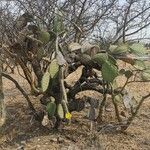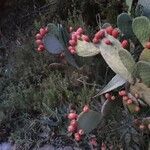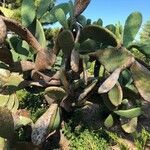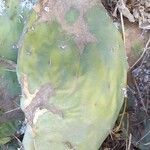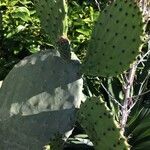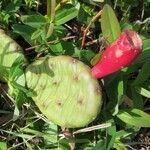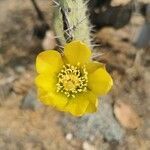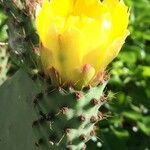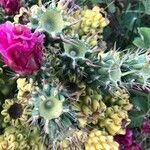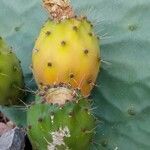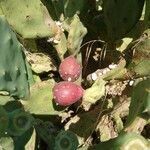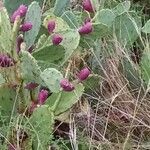Shrubs erect or small trees, 1.5-5 m tall. Trunk (when present) terete. Joints dull green or grayish green, broadly to narrowly obovate, elliptic, or oblong, (20-)25-60 × 7-20 cm, thick. Areoles usually narrowly elliptic, 2-4.5 mm. Spines usually absent, sometimes 1-6 per areole, spreading or deflexed, bristlelike or acicular, 0.3-3.2 cm, basally flattened; glochids yellow, early deciduous. Leaves conic, 3-4 mm, early deciduous. Flowers 5-8 cm in diam. Sepaloids yellow with reddish or green center, broadly ovate or obovate, to 2 cm, margin entire or denticulate, apex truncate or acute, mucronate. Petaloids spreading, yellow to orange, obovate to oblong-obovate, 2.5-3.5 × 1.5-2 cm, margin entire or erose, apex rounded, truncate, mucronate, or emarginate. Filaments yellowish, ca. 6 mm; anthers yellow, 1.2-1.5 mm. Style greenish, ca. 15 mm; stigmas (6-)7-10, cream, 3-4 mm. Fruit yellow, orange, or purplish, 5-10 × 4-9 cm, umbilicus low and concave. Seeds gray or tan, elliptic-orbicular, 4-5 × 3.5-4 mm. Fl. May-Jun.
Trees, 3-6 m; trunk to 30-45 cm diam. Stem segments green, broadly oblong to ovate to narrowly elliptic, (20-)4-60 × 2-3+ cm, low tuberculate; areoles 7-11 per diagonal row across midstem segment, rhombic to subcircular, 2-4(-5) mm diam.; wool brown. Spines 1-6 per areole, absent or very highly reduced, or in marginal to nearly all areoles, erect to spreading, whitish, tan, or brown, setaceous only or setaceous and subulate, straight to slightly curved, basally angular-flattened, 1-10(-40) mm; 0-2 small bristlelike deflexed spines to 5 mm. Glochids along adaxial margin of areole and small, inconspicuous tuft, yellowish, aging brown, less than 2 mm. Flowers: inner tepals yellow to orange throughout, 25-50 mm; filaments and anthers yellow; style bright red; stigma lobes yellow. Fruits yellow to orange to purple, 50-100 × 40-90 mm, fleshy to ± juicy, glabrous, usually spineless; areoles 45-60, evenly distributed on fruit. Seeds pale tan, subcircular, 4-5 mm diam., warped; girdle protruding to 1 mm. 2n = 88.
Shrubs or trees up to 5 m tall, forming sturdy trunks with age. Joints flattened, narrowly elliptic to ovate, varying in size, 30-60 cm long and 6-12 cm broad, attenuate below, often acute above, fairly thick, glaucous-green; areoles small to large, and then raised and woolly, with 3-6 radiating, unequally long, greyish white spines up to 3(-10) cm long, straight or occasionally slightly curved, or spineless (in older plants and some cultivars). Leaves, if developed, minute, subulate, early deciduous. Flowers about 7 cm long; hypanthium broadly cylindrical, contracted below, with numerous raised areoles spirally arranged, densely woolly and filled with glochidia, occasionally also bearing small spines and minute leaves; petaloid segments yellow or orange. Fruit ellipsoid, c. 7 cm long, reddish, succulent, edible; seeds about 5 mm long.
Shrubby or arborescent, up to 4(–5) m. tall, often with a cylindrical trunk.. Joints elliptic to narrowly obovate, flattened, often 30–40 cm. long, 15–20 cm. broad, 1–1.5 cm. thick, greyish-green; glochids yellow, deciduous; spines usually none, sometimes 1 or more, up to 1.5 cm. long, bristle-like.. Leaves subulate, 3–4 mm. long, early deciduous.. Flowers 5–8 cm. in diameter; perianth spreading, yellow or orange, longer than the style and stamens.. Ovary cylindrical, 3.5–5 cm. long, with many areoles, the upper bearing bristles up to 1.5 cm. long.. Fruit ellipsoidal or obovoid, 5–9 cm. long, 3–6 cm. in diameter, variable in colour, with edible pulp.
Shrub or tree, up to 5 m high; mostly with a trunk up to 1 m in diameter; cladodes obovate to oblong 200-600 mm long, much longer than broad, dull green or blue-green, base attenuate, fairly thick, glaucous, with straight margins; areoles small, ± 5 mm in diameter. Spines 3-6, greyish white, up to 30 mm long, or absent in older plants. Leaves caducous. Flowers: 60-70 mm long; floral tube with many areoles, with a few long glochidia in addition to many short glochidia; perianth segments yellow or orange; Oct.-Dec. Fruit ellipsoid or obovoid, 5-10 mm long, greenish to orange or red in different cultivars, with pale pulp.
A tree like cactus. It grows to 2-5 m tall. It has many branches. It is spreading and bluish-green. It has succulent pads. The joints are 20-40 cm long by 10-20 cm wide. The spines are 2-3 cm long. Spineless kinds also occur. The flowers are large and yellow. They grow on the borders of the pads. The flowers open in the daytime. They are 70-100 mm long. The filaments are pale yellow. The fruit are barrel shaped. They are 50-90 mm long. They turn yellow when ripe. There are several seeds. There are several cultivated varieties.
Succulent, branched shrub or tree, 2-5 m high, forming sturdy trunks with age. Cladodes flattened, narrowly elliptic to ovate, 300-600 x 60-120 mm, attenuate below, fairly thick, glaucous-green; areoles with 3-6 radiating, greyish white spines ± 30 mm long (spineless in older plants and certain cultivars). Leaves early deciduous. Flowers yellow or orange. Flowering time Oct.-Dec. Fruit ellipsoid, ± 70 mm long, reddish, succulent berries, edible.
Shrub or tree, up to 5 m high. Joints flattened, narrowly elliptic to ovate, 60-120 mm broad, fairly thick, glaucous, with straight margins; areoles small, ± 5 mm in diameter, with 3-6 greyish white spines, up to 30 mm long, or absent in older plants. Fruit ovoid to barrel-shaped, reddish or yellowish. Flowers yellow or orange.
